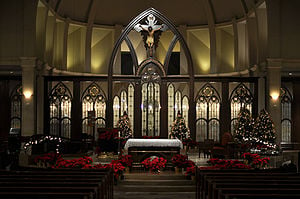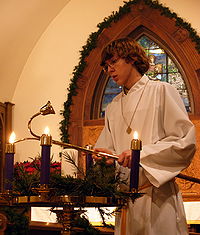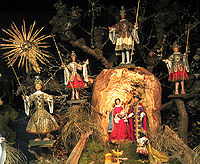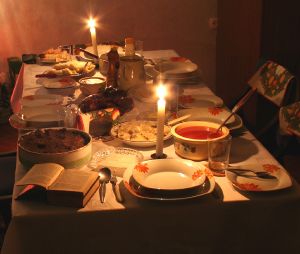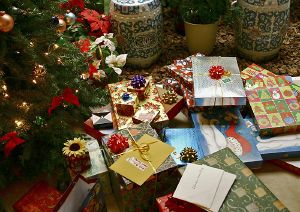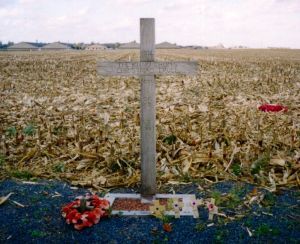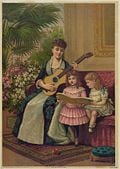Christmas Eve
| Christmas Eve | |
|---|---|
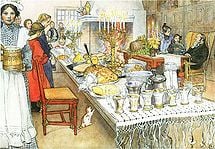
| |
| Julaftonen (Christmas Eve), a 1904–05 watercolor painting by Carl Larsson | |
| Also called | Christmas Evening Christmas Vigil Day before Christmas Night before Christmas |
| Observed by | Christians Many non-Christians[1] |
| Type | Christian, cultural |
| Significance | Day or evening preceding the traditional birthday of Jesus |
| Date | December 24 (alternatively January 6 or 18)[2][3] |
| Observances | Gift shopping, gift giving, goodwill greetings, Midnight Mass, other church services, meals, preparations for the arrival of Christmas gift-bringers, preparing for Christmas |
| Related to | Christmas Day, Christmastide, New Year's Eve |
Christmas Eve is the evening or day before Christmas Day, the widely celebrated annual holiday. It occurs on December 24 in Western Christianity and the secular world, and is considered one of the most culturally significant celebrations in Christendom and Western society, where it is widely observed as a full or partial holiday in anticipation of Christmas Day.
Overview
Christmas celebrations have long begun on the night before the holiday, due in part to the Christian liturgical day starting at sunset,[4] a practice inherited from Jewish tradition[5] and based on the story of Creation in the Book of Genesis: "And there was evening, and there was morning – the first day."[6] Many churches still ring their church bells and hold prayers in the evening before holidays; for example, the Nordic Lutheran churches.[7] Since tradition holds that Jesus was born at night (based in Luke 2:6-8), Midnight Mass is celebrated on Christmas Eve, traditionally at midnight, in commemoration of his birth.[8] The idea of Jesus being born at night is reflected in the fact that Christmas Eve is referred to as Heilige Nacht (Holy Night) in German, Nochebuena (the Good Night) in Spanish and similarly in other expressions of Christmas spirituality, such as the song "Silent Night, Holy Night".
Many other varying cultural traditions and experiences are also associated with Christmas Eve around the world, including the gathering of family and friends, the singing of Christmas carols, the illumination and enjoyment of Christmas lights, trees, and other decorations, the wrapping and/or opening of gifts, and general preparation for Christmas Day. Legendary Christmas gift-bearing figures including Santa Claus, Father Christmas, Christkind, and Saint Nicholas are also often said to depart for their annual journey to deliver presents to children around the world on Christmas Eve, although until the Protestant introduction of Christkind in 16th-century Europe,[9] such figures were said to instead deliver presents on the eve of Saint Nicholas' feast day (December 6).
Religious traditions
Western churches
Roman Catholics and Anglicans traditionally celebrate Midnight Mass, which begins either at or sometime before midnight on Christmas Eve. This ceremony, which is held in churches throughout the world, celebrates the birth of Christ, which is believed to have occurred at night.
In recent years some churches have scheduled their "Midnight" Mass as early as 7 pm. In Spanish-speaking areas, the Midnight Mass is sometimes referred to as Misa de Gallo, or "Missa do Galo", in Portuguese ("Rooster's Mass"). In the Philippines, the custom has expanded into the nine-day Simbang Gabi, when Filipinos attend dawn Masses (traditionally beginning around 04:00 to 05:00 PST) from 16 December, continuing daily until Christmas Eve. In 2009 Vatican officials scheduled the Midnight Mass to start at 10 pm so the 82 year old Pope Benedict XVI would not have too late a night.[10]
Whilst not performing any kind of Mass per se, the Church of Scotland has a service beginning just before midnight, wherein carols are sung. The Church of Scotland no longer holds Hogmany services on New Year's Eve, however, The Christmas Eve Services are still very popular. On Christmas Eve, the Christ Candle in the center of the Advent wreath is traditionally lit in many church services. In candlelight services, while singing "Silent Night", each member of the congregation receives a candle and passes along their flame which is first received from the Christ Candle.
Lutherans traditionally practice Christmas Eve Eucharistic traditions typical of Germany and Scandinavia. "Krippenspiele" (Nativity plays), special festive music for organ, vocal and brass choirs and candlelight services make Christmas Eve one of the highlights in the Lutheran Church calendar. A nativity scene may be erected indoors or outdoors Christmas Day, and is composed of figurines depicting the infant Jesus resting in a manger, Mary, and Joseph.[11] Other figures in the scene may include angels, shepherds, and various animals. The figures may be made of any material,[12] and arranged in a stable or grotto. The Magi may also appear, and are sometimes not placed in the scene until the week following Christmas to account for their travel time to Bethlehem. While most home nativity scenes are packed away at Christmas or shortly thereafter, nativity scenes in churches usually remain on display until the feast of the Baptism of the Lord.[12]
Christmas Vespers are popular in the early evening, and midnight services are also widespread in regions which are predominately Lutheran. The old Lutheran tradition of a Christmas Vigil in the early morning hours of Christmas Day (Christmette) can still be found in some regions. In eastern and middle Germany, congregations still continue the tradition of "Quempas singing": separate groups dispersed in various parts of the church sing verses of the song "He whom Shepherds once came Praising" (Quem pastores) responsively.
Methodists celebrate the evening in different ways. Some, in the early evening, come to their church to celebrate Holy Communion with their families. The mood is very solemn, and the only visible light is the Advent Wreath, and the candles upon the Lord's Table. Others celebrate the evening with services of light, which include singing the song "Silent Night" as a variety of candles (including personal candles) are lit. Other churches have late evening services at 11 pm, so the church can celebrate Christmas Day together with the ringing of bells at midnight. Others offer Christmas Day services, as well.
The annual "Nine Lessons and Carols" broadcast from King's College, Cambridge, on Christmas Eve, has established itself as one of the signs that Christmas has begun in the United Kingdom.[13] It is broadcast outside the UK via the BBC World Service, and is also bought by broadcasters around the world.[13]
Eastern churches
In the Byzantine Rite, Christmas Eve is referred to as Paramony ("preparation"). It is the concluding day of the Nativity Fast and is celebrated as a day of strict fasting by those devout Byzantine Christians who are physically capable of doing so. In some traditions, nothing is eaten until the first star appears in the evening sky, in commemoration of the Star of Bethlehem. The liturgical celebration begins earlier in the day with the celebration of the Royal Hours, followed by the Divine Liturgy combined with the celebration of Vespers, during which a large number of readings from the Old Testament are chanted, recounting the history of salvation. After the dismissal at the end of the service, a new candle is brought out into the center of the church and lit, and all gather round and sing the Troparion and Kontakion of the Feast.
In the evening, the All-Night Vigil for the Feast of the Nativity is composed of Great Compline, Matins and the First Hour. The Byzantine services of Christmas Eve are intentionally parallel to those of Good Friday, illustrating the theological point that the purpose of the Incarnation was to make possible the Crucifixion and Resurrection. This is illustrated in Eastern icons of the Nativity, on which the Christ Child is wrapped in swaddling clothes reminiscent of his burial wrappings. The child is also shown lying on a stone, representing the Tomb of Christ, rather than a manger. The Cave of the Nativity is also a reminder of the cave in which Jesus was buried.
The services of Christmas Eve are also similar to those of the Eve of Theophany (Epiphany), and the two Great Feasts are considered one celebration.
In some Orthodox cultures, after the Vesperal Liturgy the family returns home to a festive meal, but one at which Orthodox fasting rules are still observed; i.e., no meat or dairy products (milk, cheese, eggs, etc.) are consumed (see below for variations according to nationality). Then they return to the church for the All-Night Vigil.
The next morning, Christmas Day, the Divine Liturgy is celebrated again, but with special features that occur only on Great Feasts of the Lord. After the dismissal of this Liturgy, the faithful customarily greet each other with the kiss of peace and the words: "Christ is Born!", to which the one being greeted responds: "Glorify Him!" (these are the opening words of the Canon of the Nativity that was chanted the night before during the Vigil). This greeting, together with many of the hymns of the feast, continue to be used until the leave-taking of the feast on December 29.
The first three days of the feast are particularly solemn. The second day is known as the Synaxis of the Theotokos, and commemorates the role of the Virgin Mary in the Nativity of Jesus. The third day is referred to simply as "the Third Day of the Nativity". The Saturday and Sunday following December 25 have special Epistle and Gospel readings assigned to them. December 29 celebrates the Holy Innocents.
Byzantine Christians observe a festal period of twelve days, during which no one in the Church fasts, even on Wednesdays and Fridays, which are normal fasting days throughout the year. During this time one feast leads into another: December 25–31 is the afterfeast of the Nativity; January 2–5 is the forefeast of the Epiphany.
Meals
- Further information: List of Christmas dishes
Bulgaria
In Bulgaria, the meal consists of an odd number of lenten dishes in compliance with the rules of fasting. They are usually the traditional sarma, bob chorba (bean soup), fortune pita (pastry with a fortune in it), stuffed peppers, nuts.[14] The meal is often accompanied with wine or Bulgaria's traditional alcoholic beverage rakia.
France
In French-speaking places, Réveillon is a long dinner eaten on Christmas Eve.
Italy
While other Christian families throughout the world celebrate the Christmas Eve meal with various meats, Italians and Sicilians celebrate the traditional Catholic "Feast of the Seven Fishes" which was historically served after a 24 hour fasting period. Although pre-Christmas fasting is not a popular custom still practiced, Italian-Americans still enjoy meatless Christmas Eve feast[15] and attend the Midnight Mass. In various cultures, a festive dinner is traditionally served for the family and close friends in attendance, when the first star (usually Sirius) arrives on the sky.
Poland
Similar tradition ("Wigilia", or 'Christmas Vigil') exists in Poland. Template:Citation needed-span According to the Słownik etymologiczny języka polskiego (Etimological Dictionary of the Polish Language) by Aleksander Brückner, the number of dishes was traditionally related to a social class: peasants' vigil consisted of 5 or 7 dishes, gentry usually had 9, and aristocracy - 11 dishes. The number 12 is allowed occasionally. It is obligatory to try a portion of all of them. There number of guests cannot be odd.[16][17]
Russia, Ukraine and Lithuania
In Russia, Ukraine, and Lithuania, a traditional meatless 12-dishes Christmas Eve Supper is served on Christmas Eve before opening gifts. This is known as the "Holy Meal". The table is spread with a white cloth symbolic of the swaddling clothes the Child Jesus was wrapped in, and a large white candle stands in the center of the table symbolizing Christ the Light of the World. Next to it is a round loaf of bread symbolizing Christ Bread of Life. Hay is often displayed either on the table or as a decoration in the room, reminiscent of the manger in Bethlehem. The twelve dishes (which differ by nationality or region) symbolize the Twelve Apostles.
The Holy Meal was a common Eastern Orthodox tradition in the Russian Empire, but during the era of the Soviet Union it was greatly discouraged as a result of the official atheism of the former regime. It is coming back in Russia and continues to be popular in Ukraine.
The main attribute of Holy Meal in Ukraine is kutia, a sweet grain pudding. The other typical dishes are borscht, Varenyky, a traditional Christmas compote called uzvar and dishes made of fish, phaseolus and cabbage.
Serbia
In accordance with the Christmas traditions of the Serbs, their festive meal has a copious and diverse selection of foods, although it is prepared according to the rules of fasting.
As well as a round, unleavened loaf of bread and salt, which are necessary, this meal may comprise roast fish, cooked beans, sauerkraut, noodles with ground walnuts, honey, and wine.
Families in some Slavic countries leave an empty place at the table for guests (alluding to Mary and Joseph looking for shelter in Bethlehem).
Gift giving
During the Reformation in 16th and 17th-century Europe, many Protestants changed the gift bringer to the Christ Child or Christkindl, and the date of giving gifts changed from December 6 to Christmas Eve.[18] It is the night when Santa Claus makes his rounds delivering gifts to good children. Many trace the custom of giving gifts to the Magi who brought gifts for the Christ child in the manger.
In the Czech Republic, Slovakia, Croatia and Hungary, where Saint Nicholas (sv. Mikuláš/szent Mikulás) gives his sweet gifts on December 6, the Christmas gift-giver is the Child Jesus (Ježíšek in Czech, Jézuska in Hungarian, Ježiško in Slovak and Isusek in Croatian).[19]
In most parts of Austria, Germany, Poland and Switzerland, presents are traditionally exchanged in the evening of December 24. Children are commonly told that presents were brought either by the Christkind (German for: Christchild),[20] or the Weihnachtsmann. Both leave the gifts, but are in most families not seen doing so. In Germany, the gifts are also brought on 6 December by Knecht Ruprecht.
In Finland, Joulupukki, in Norway Julenissen and in Sweden Jultomten, personally meets children and gives presents in the evening of Christmas Eve.[21][22]
In Argentina, Austria, Colombia, Denmark, Estonia, Finland, France, Germany, Hungary, Slovakia, Iceland, Latvia, Luxembourg, Norway, Poland, Portugal, Quebec, Romania, Uruguay, Sweden, Switzerland, and the Czech Republic, Christmas presents are opened mostly on the evening of the 24th, – this is also the tradition among the British Royal Family, due to their mainly German ancestry[23] – while in Italy, the United States, the United Kingdom, Republic of Ireland, English Canada, South Africa, New Zealand and Australia, this occurs mostly on the morning of Christmas Day.
In other Latin American countries, people stay awake until midnight, when they open the presents.
In Spain, gifts are traditionally opened on the morning of January 6, Epiphany day ("Día de Los Tres Reyes Magos"),[24] though in some other countries, like Argentina and Uruguay, people receive presents both around Christmas and on the morning of Epiphany day.
In Belgium and the Netherlands they also celebrate Sinterklaas on December 5.[25]
Christmas Eve around the world

Christmas Eve is celebrated in different ways around the world, varying by country and region. Elements common to many areas of the world include the attendance of special religious observances such as a midnight Mass or Vespers, and the giving and receiving of presents. Along with Easter, Christmastime is one of the most important periods on the Christian calendar, and is often closely connected to other holidays at this time of year, such as Advent, the Feast of the Immaculate Conception, St. Nicholas Day, St. Stephen's Day, New Year's, and the Feast of the Epiphany.
Jewish traditions on Christmas Eve
Nittel Nacht
Some Jews observe Christmas Eve as "Nittel Nacht", a minor folk (sad) holiday with its own unique customs.
Beginning no later than the 1500s, a number of Jewish customs developed around Christmas Eve, often reflecting feelings of mourning over the historic birth of Christianity and fear of pogroms by contemporary Christian neighbors. By the 17th century, European Jews began referring to the night as "Nittel Nacht" and treating it as a kind of minor day of mourning.[26]
Most prominent among these customs is the tradition to not engage in Torah study on Nittel Nacht. Some have theorized that this custom developed out of fear of heightened antisemitic persecution on Christmas Eve, with Jews avoiding synagogues and study halls where they would be easy targets, and instead opting to spend the night safe at home.
Less popular is a custom to not engage in marital relations on Nittel Nacht. This custom, as well as that to not study Torah, are similar to the traditions of mourning practiced on Tisha B'av.
With Torah study off the table for the evening, a number of traditions developed as to how to spend one's night. Most well known is a custom to play cards, dreidel, chess or other table games. (Some modern synagogues hold poker nights on Christmas Eve, in a continuation of this once home-bound tradition.) The Lubavitcher Rebbe was known to spend his Nittel Nachts sewing. Some spend the night ripping a year's worth of toilet paper and paper towels, an errand helpful for observing certain Sabbath laws.[26]
Today, where most Jews do not fear antisemitic attacks on Christmas Eve, and most Jews hold a more ecumenical view towards the birth of Christianity, observance of Nittel Nacht is less popular than once was. That said, many yeshivas still do not conduct Torah classes on Christmas Eve, and card-playing remains a well known Nittel Nacht past time.
In contemporary American-Jewish culture
The significant amount of vacation travel, and travel back to family homes, means that Christmas Eve is also frequently linked to social events and parties, worldwide.[27][28][29][30][31] Due to the family gathering and religious worship activities that are central to Christmas Eve for Christians but which Jews do not typically engage in,[32] a series of events on the night of December 24 have been made available to Jews in various regions of the world.[33] Matzo Ball events and parties are an option for single Jews. Jews in interfaith relationships may prefer to participate in Chrismukkah events and parties. However, Jewish people are invited to Christmas Eve parties and plenty will attend, and some host Christmas Eve parties for others.
Historical events
A number of historical events have been influenced by the occurrence of Christmas Eve.
Christmas truce
During World War I in 1914 and 1915 an unofficial Christmas truce took place, particularly that between British and German troops. The truce began on Christmas Eve, December 24, 1914, when German troops began decorating the area around their trenches in the region of Ypres, Belgium, for Christmas. They began by placing candles on trees, then continued the celebration by singing Christmas carols, most notably "Stille Nacht" ("Silent Night"). The British troops in the trenches across from them responded by singing English carols. The two sides shouted Christmas greetings to each other. Soon thereafter, there were calls for visits across the "No man's land" where small gifts were exchanged. The truce also allowed a breathing spell where recently fallen soldiers could be brought back behind their lines by burial parties. Funerals took place as soldiers from both sides mourned the dead together and paid their respects. At one funeral in No Man's Land, soldiers from both sides gathered and read a passage from Psalm 23. The truce occurred in spite of opposition at higher levels of the military command. Earlier in the autumn, a call by Pope Benedict XV for an official truce between the warring governments had been ignored.

Apollo 8 reading from Genesis
On December 24, 1968, in what was the most watched television broadcast to that date, the astronauts Bill Anders, Jim Lovell and Frank Borman of Apollo 8 surprised the world with a reading of the Creation from the Book of Genesis as they orbited the moon. Madalyn Murray O'Hair, an atheist activist, filed a lawsuit under the Establishment Clause of the First Amendment. The suit was dismissed by the US Supreme Court.
In 1969, the United States Postal Service issued a stamp (Scott # 1371) commemorating the Apollo 8 flight around the moon. The stamp featured a detail of the famous photograph of the Earthrise over the moon (NASA image AS8-14-2383HR) taken by Anders on Christmas Eve, and the words, "In the beginning God..."
See also
ReferencesISBN links support NWE through referral fees
- ↑ In the U.S., Christmas Not Just for Christians Gallup, Inc. December 24, 2008. Retrieved November 14, 2014.
- ↑ Several traditions of Eastern Christianity that use the Julian calendar celebrate on December 24 according to that calendar, which is now January 6 on the Gregorian calendar. Some Armenian churches use the Julian calendar, thus celebrating Christmas Eve on January 18 on the Gregorian calendar.
- ↑ John Ramzy, The Glorious Feast of Nativity: 7 January? 29 Kiahk? 25 December? Coptic Orthodox Church Network. Retrieved November 14, 2014.
- ↑ Christian Calendar. Jerusalem Center for Jewish-Christian Relations. Retrieved 2010-12-29.
- ↑ Kessler, Edward (2005). A dictionary of Jewish-Christian relations. Cambridge, Cambridgeshire, United Kingdom: Cambridge university Press.
- ↑ (2005) Bible - NIV.
- ↑ Helgmålsringning. Natinalencyclopedin. Retrieved 2010-12-29.
- ↑ Vatican Today. Retrieved 2010-12-29.
- ↑ Forbes, Bruce David, Christmas: a candid history, University of California Press, 2007, ISBN 0-520-25104-0, pp. 68-79.
- ↑ "Woman knocks Pope down at Christmas Mass", British Broadcasting Company, 2009-12-25.
- ↑ Vermes, Geza. The Nativity: History and Legend. Penguin, 2006
- ↑ 12.0 12.1 Dues, Greg.Catholic Customs and Traditions: A Popular Guide Twenty-Third Publications, 2000.
- ↑ 13.0 13.1 Alex Webb (24 December 2001), Choir that sings to the world, BBC News
- ↑ Bulgarian Main Courses
- ↑ Rachael Ray's Official Website - Feast of Seven Fishes – A Sicilian Christmas Eve Tradition. Rachaelray.com. Retrieved 2014-02-14.
- ↑ 12, 11, 9? Ile dań na Wigilie? - Święta. polskieradio.pl (2010-12-19). Retrieved 2014-02-14.
- ↑ Wigilia. Polishcenter.org. Retrieved 2014-02-14.
- ↑ Forbes, Bruce David, Christmas: a candid history, University of California Press, 2007, ISBN 0-520-25104-0, pp. 68–79.
- ↑ The Christmas encyclopedia McFarland p.143. & Co., 2005
- ↑ The Christmas Almanack p.56. Random House Reference, 2004
- ↑ Llewellyn's Sabbats Almanac: Samhain 2010 to Mabon 2011 p.64. Llewellyn Worldwide, 2010
- ↑ Festivals of Western Europe p.202. Forgotten Books, 1973
- ↑ Stephen Fry revealed this during a discussion of Christmas traditions during an edition of QI
- ↑ Francis, Charles Wisdom Well Said p.224 Levine Mesa Press, 2009
- ↑ Concepts of person in religion and thought Walter de Gruyter, 1990
- ↑ 26.0 26.1 Cohen, Benyamin. The litte-known Jewish holiday. Slate. Retrieved 2012-12-24.
- ↑ Eugene Fodor, Fodor's South 1980: Alabama, Florida, Georgia, Kentucky, Louisiana, 1979, at p. 87, available at Google Books
- ↑ Gary Sigley, A Chinese Christmas Story, in Shi-xu, ed., Discourse as Cultural Struggle, 2007, at p. 99, available at Google Books
- ↑ Adebayo Oyebade, Culture and Customs of Angola, 2007, at pp. 103, 140, available at Google Books
- ↑ See, e.g., Clubzone, Twas the Night Before Christmas @ Tonic @ Tonic Nightclub Vancouver BC, 2009
- ↑ See, e.g., Upcoming.org, The College Night Out, 2009
- ↑ Brenda Lane Richardson, Deciding to Celebrate Christmas, or Not, New York Times, December 16, 1987
- ↑ Christmas Eve parties now a Jewish tradition, Associated Press (MSNBC), December 23, 2006
External links
| |||||||
Credits
New World Encyclopedia writers and editors rewrote and completed the Wikipedia article in accordance with New World Encyclopedia standards. This article abides by terms of the Creative Commons CC-by-sa 3.0 License (CC-by-sa), which may be used and disseminated with proper attribution. Credit is due under the terms of this license that can reference both the New World Encyclopedia contributors and the selfless volunteer contributors of the Wikimedia Foundation. To cite this article click here for a list of acceptable citing formats.The history of earlier contributions by wikipedians is accessible to researchers here:
The history of this article since it was imported to New World Encyclopedia:
Note: Some restrictions may apply to use of individual images which are separately licensed.
